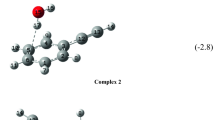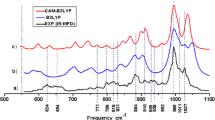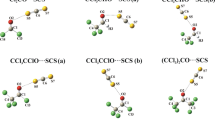Abstract
Ab initio near-equilibrium potential energy and dipole moment surfaces for the bent CuNO, AgNO, and AuNO molecules have been calculated under the Feller–Peterson–Dixon (FPD) composite framework at the coupled cluster level of theory including complete basis set extrapolation, outer-core correlation, scalar relativistic effects, and spin–orbit coupling. The Brueckner coupled cluster doubles with perturbative triples method, BCCD(T), was used to greatly improve upon CCSD(T), which was particularly problematic for CuNO. In the latter case, the BCCD(T) vibrational frequencies showed significant differences compared to CCSD(T), e.g., nearly 65 cm−1 for the NO stretching frequency, and BCCD(T) also resulted in much better agreement with the available experimental frequencies. A full range of ro-vibrational spectroscopic constants are given for all three molecules of this study using the accurate composite potential energy functions and employing second-order vibrational perturbation theory.
Similar content being viewed by others
References
Andrews L, Citra A (2002) Chem Rev 102:885–912
Pietrzyk P, Piskorz W, Sojka Z, Broclawik E (2003) J Phys Chem B 107:6105–6113
Pietrzyk P, Sojka Z (2005) J Phys Chem A 109:10571–10581
Sulzle D, Schwarz H, Moock KH, Terlouw JK (1991) Int J Mass Spectrom 108:269–272
Krim L, Wang XF, Manceron L, Andrews L (2005) J Phys Chem A 109:10264–10272
Chiarelli JA, Ball DW (1994) J Phys Chem 98:12828–12830
Jiang L, Xu Q (2007) J Phys Chem A 111:2690–2696
Zhou M, Andrews L (2000) J Phys Chem A 104:2618
Ball DW, Chiarelli JA (1995) J Mol Struct 372:113–125
Ruschel GK, Nemetz TM, Ball DW (1996) J Mol Struct 384:101–114
Hrušák J, Koch W, Schwarz H (1994) J Chem Phys 101:3898–3905
Uzunova EL (2009) J Phys Chem A 113:11266–11272
Krishna BM and Marquardt R (2012) J Chem Phys 136:
Blanchet C, Duarte HA, Salahub DR (1997) J Chem Phys 106:8778–8787
Cornaton Y, Krishna BM, Marquardt R (2013) Mol Phys 111:2263–2282
Citra A, Andrews L (2001) J Phys Chem A 105:3042–3051
Chao C-C, Lunsford JH (1974) J Phys Chem 78:1174–1177
Tielens F, Gracia L, Polo V, Andres J (2007) J Phys Chem A 111:13255–13263
Jiang L, Kohyama M, Haruta M, Xu Q (2008) J Phys Chem A 112:13495–13499
Teng YL, Kohyama M, Haruta M, and Xu Q (2009) J Chem Phys 130:
Kuang XJ, Wang XQ, Liu GB (2011) Eur Phys J D 61:71–80
Olvera-Neria O, Bertin V, Poulain E (2011) Int J Quantum Chem 111:2054–2063
Citra A, Wang XF, Andrews L (2002) J Phys Chem A 106:3287–3293
Feller D, Peterson KA, and Dixon DA (2008) J Chem Phys 129:
Hampel C, Peterson KA, Werner HJ (1992) Chem Phys Lett 190:1–12
Dunning TH Jr (1989) J Chem Phys 90:1007–1023
Kendall RA, Dunning TH, Harrison RJ (1992) J Chem Phys 96:6796–6806
Peterson KA, Puzzarini C (2005) Theor Chem Acc 114:283–296
Figgen D, Rauhut G, Dolg M, Stoll H (2005) Chem Phys 311:227–244
Dykstra CE (1977) Chem Phys Lett 45:466–469
Handy NC, Pople JA, Head-Gordon M, Raghavachari K, Trucks GW (1989) Chem Phys Lett 164:185–192
Noga J, Bartlett RJ (1987) J Chem Phys 86:7041
Scuseria GE, Schaefer HF (1988) Chem Phys Lett 152:382
Lee TJ and Taylor PR (1989) Int. J. Quantum Chem. 36(Suppl. S23):199
Karton A, Martin JML (2006) Theor Chem Acc 115:330–333
Feller D, Peterson KA, and Hill JG (2011) J Chem Phys 135:
Martin JML (1996) Chem Phys Lett 259:669–678
Douglas M, Kroll NM (1974) Ann Phys (New York) 82:89–155
Jansen G, Hess BA (1989) Phys Rev A 39:6016–6017
Reiher M, Wolf A (2004) J Chem Phys 121:10945–10956
de Jong WA, Harrison RJ, and Dixon DA (2001) J Chem Phys 114:48–53
Becke AD (1993) J Chem Phys 98:5648–5652
Lee YS, Ermler WC, Pitzer KS (1977) J Chem Phys 67:5861–5875
Carter S, Handy NC (1987) J Chem Phys 87:4294
Hoy AR, Mills IM, Strey G (1972) Mol Phys 24:1265
Senekowitsch J, Ph.D. thesis, Universität Frankfurt, Frankfurt,Germany, 1988.
Eckart C (1935) Phys Rev 47:552
Adler-Golden SM, Carney GD (1985) Chem Phys Lett 113:582–584
Saue T, DIRAC, a relativistic ab initio electronic structure program, Release DIRAC18 (2018), written by T. Saue, L. Visscher, H. J. Aa. Jensen, and R. Bast, with contributions from V. Bakken, K. G. Dyall, S. Dubillard, U. Ekström, E. Eliav, T. Enevoldsen, E. Faßhauer, T. Fleig, O. Fossgaard, A. S. P. Gomes, E. D. Hedegård, T. Helgaker, J. Henriksson, M. Iliaš, Ch. R. Jacob, S. Knecht, S. Komorovský, O. Kullie, J. K. Lærdahl, C. V. Larsen, Y. S. Lee, H. S. Nataraj, M. K. Nayak, P. Norman, G. Olejniczak, J. Olsen, J. M. H. Olsen, Y. C. Park, J. K. Pedersen, M. Pernpointner, R. Di Remigio, K. Ruud, P. Sałek, B. Schimmelpfennig, A. Shee, J. Sikkema, A. J. Thorvaldsen, J. Thyssen, J. van Stralen, S. Villaume, O. Visser, T. Winther, and S. Yamamoto (available at https://doi.org/10.5281/zenodo.2253986, see also http://www.diracprogram.org).
Werner H-J (2019) MOLPRO, version 2019.2, a package of ab initio programs, H.-J. Werner, P. J. Knowles, G. Knizia, F. R. Manby, M. Schütz, P. Celani, W. Györffy, D. Kats, T. Korona, R. Lindh, A. Mitrushenkov, G. Rauhut, K. R. Shamasundar, T. B. Adler, R. D. Amos, S. J. Bennie, A. Bernhardsson, A. Berning, D. L. Cooper, M. J. O. Deegan, A. J. Dobbyn, F. Eckert, E. Goll, C. Hampel, A. Hesselmann, G. Hetzer, T. Hrenar, G. Jansen, C. Köppl, S. J. R. Lee, Y. Liu, A. W. Lloyd, Q. Ma, R. A. Mata, A. J. May, S. J. McNicholas, W. Meyer, T. F. Miller III, M. E. Mura, A. Nicklass, D. P. O'Neill, P. Palmieri, D. Peng, K. Pflüger, R. Pitzer, M. Reiher, T. Shiozaki, H. Stoll, A. J. Stone, R. Tarroni, T. Thorsteinsson, M. Wang, and M. Welborn, , see https://www.molpro.net.
Acknowledgements
The authors gratefully acknowledge the support of the U.S. Department of Energy, Office of Science, Office of Basic Energy Sciences, Heavy Element Chemistry Program through Award Number DE-SC0008501.
Author information
Authors and Affiliations
Corresponding author
Additional information
Publisher's Note
Springer Nature remains neutral with regard to jurisdictional claims in published maps and institutional affiliations.
"Festschrift in honor of Prof. Fernando R. Ornellas” Guest Edited by Adélia Justino Aguiar Aquino, Antonio Gustavo Sampaio de Oliveira Filho & Francisco Bolivar Correto Machado.
Electronic supplementary material
Below is the link to the electronic supplementary material.
Rights and permissions
About this article
Cite this article
Lu, Q., Peterson, K.A. Coupled cluster spectroscopic properties of the coinage metal nitrosyls, M–NO (M = Cu, Ag, Au). Theor Chem Acc 139, 81 (2020). https://doi.org/10.1007/s00214-020-02597-w
Received:
Accepted:
Published:
DOI: https://doi.org/10.1007/s00214-020-02597-w




